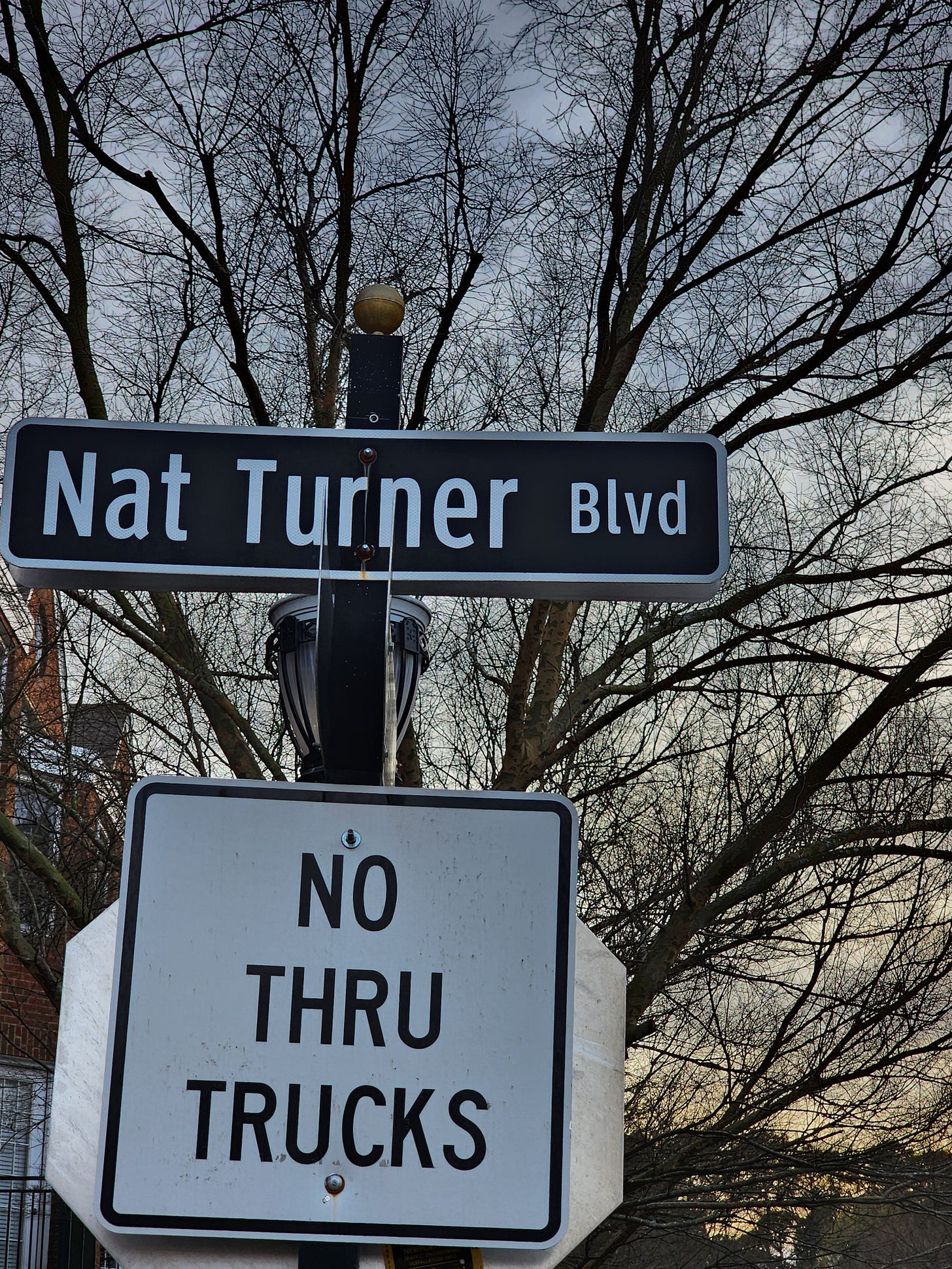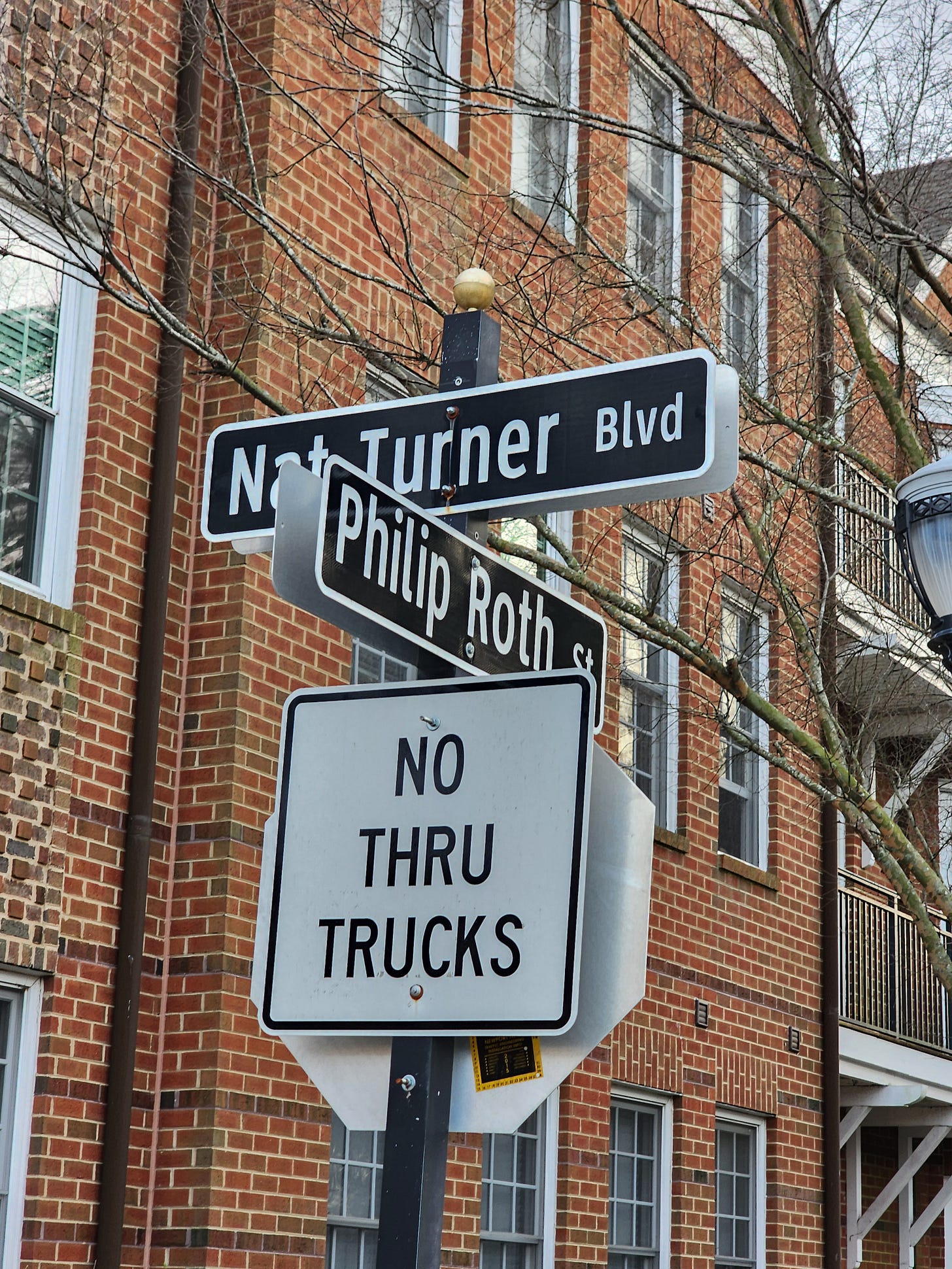Recently I went down to Newport News, Virginia to visit my mother and other family members. My wife and I were driving to see my mom when I spotted a street sign that surprised me — Nat Turner Boulevard.
For those not up on their American history, Turner was an enslaved preacher in Southampton, Virginia, who had a prophetic vision that inspired him to organize a four day long rebellion in August 1831, resulting in the deaths of fifty-five white men, women and children in perhaps the bloodiest, and certainly most famous, uprising against United States slavery. Turner was born on October 2, 1800 and, from an early age, displayed “natural intelligence and quickness of apprehension, surpassed by few,” according locals. Turner grew up with a strong interest in religion and immersed himself in the Bible. A reward notice described him as slender young man, only five feet seven and 160 pounds, a frame that belied a natural charisma that led blacks, as well as a few whites, to view him as a prophet, who saw nature as a backdrop in which God “placed signs and omens.”
Between 1822 and 1828 Turner claimed to have had ten supernatural experiences that included visions of the Holy Ghost. On May 12th of 1831 Turner claimed to have heard “a loud noise in the heavens” and that Christ “had laid down the yoke of he had borne for the sins of men, and that I should take it on and fight against the Serpent, for the time was fast approaching when the first should be last and the last should be first.” Apparently Turner had viewed an eclipse and took it as a sign for God. After the four day rebellion was put down, Turner eluded capture until October 31. Turner was tried November 5 and hung November 11. After his execution the locals dissected and frayed his body with his skin apparently used to make souvenir purses.
While incarcerated Turner spoke with attorney Thomas R. Grey, who quickly published ‘The Confessions of Nat Turner,’ a text that many have questioned the overall veracity of, but that remains the only first person insight in his thinking. If the uprising and that book were Turner’s legacy, I doubt Turner would have a boulevard named after him — it’s rare that scaring the hell of white people and becoming a folk hero to the enslaved is documented in such a benign matter.
Now let’s leap ahead some one hundred and thirty plus years to 1967 when William Styron, native son of Newport News and one of America’s finest novelist, published his own fictional ‘The Confessions of Nat Turner,’ which won the Pulitzer Prize for literature a year later and was a lightning rod for controversy. In the middle of the civil rights movement, for a celebrated white writer to enter the mind of a black man who organized the deaths of scores of whites, was either ballsy as hell or incredibly arrogant. Just think of the social media frenzy if it happened now! Of course, it didn’t go down smoothly in ‘67 either.
While many high profile literary names defended Styron’s work, including James Baldwin and Ralph Ellison, many other black writers and historians were outraged. In response the historian John Henrik Clarke edited ‘William Styron’s Nat Turner: Ten Black Writers Respond,’ which included prominent authors like Lerone Bennett Jr., John O Killens, Alvin Poussaint, and John A Williams. They argued that Styron had distorted Turner’s character, made him a bumbling planner, and put him enthrall to white women, which being disinterested in women of his race. No one used the word “appropriation” in the ‘60s as its used now, but that was the underlying theme of the criticism. Once Styron’s novel was taught at universities. With time its been replaced by the texts on the black experience by African-American authors, while Styron is now best remembered for his 1979 novel, ‘Sophie’s Choice,’ which later became a beloved movie starring Meryl Streep.
So what does William Styron have to do with a street sign in 21st century Virginia? Welcome to Port Warwick, a mixed use “new urbanism” development built on 150 acres and named after a fictional city in Styron’s 1951 novel ‘Lie Down in Darkness.’ At the center of Port Warwick is Styron Square and the surrounding streets bare the names of authors that, according to the late author, “represent the best in the great flowering of American literary art.” So Port Warwick contains streets named after Walt Whitman, Philip Roth, Flannery O’Connor, Thomas Wolf, and Herman Melville. However, it’s two main boulevards are named after characters from Styron’s work — Loftis is the protagonist of ‘Lie Down in Darkness’ and, yes, Nat Turner is the name of the other. (If you can get someone to sell, condos on Nat Turner pay $2782 in Virginia state tax a year.) Styron died in 2006, the same year construction ended on Port Warwick, and he was part of the naming committee.
In a country where history is as fleeting as yesterday’s weather, I wonder if making Nat Turner a benign name in a street sign is a symbol of progress and/or a muting of the anger behind his violent actions? Moreover, does linking Turner to the novel, turn him into a fictional creation and not the historical figure he really? Have the residents of Nat Turner Boulevard even even researched the name or do they think he’s Tina Turner’s brother? These are just a few of the questions that ran through my dome as we passed this street sign.
Later in the day we went back to Port Warwick ‘cause I wanted to get some pix of the signage. That’s when I spotted that Nat Turner Boulevard crossed Philip Roth Street, a crazy conjunction of a black prophetic rebel and the Jewish bard of Newark. I laughed, thought “Only in America,” and snapped the photo above.



